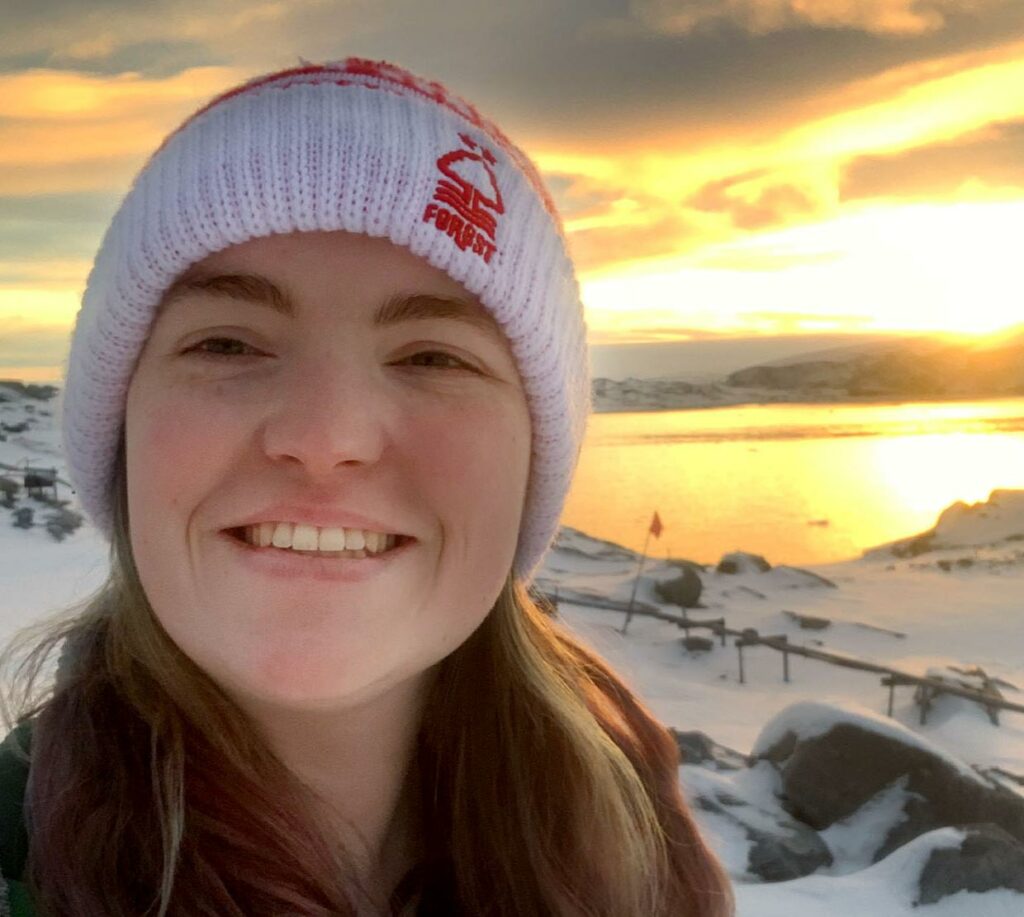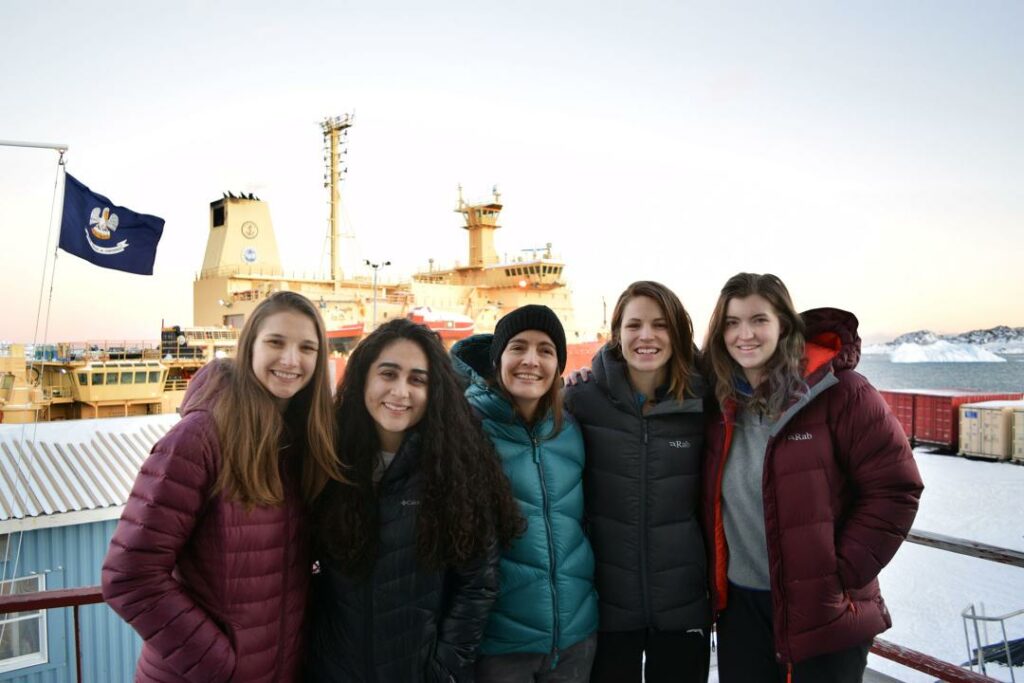Giulia Wood’s summer activities — or, in her case, winter — have included polar plunges into the Southern Ocean, listening to cracking glaciers and conducting research on Antarctic krill.
The Honors biochemistry and molecular biology student is part of Kim Bernard’s all-women research team studying how juvenile krill behave during the winter. This year is the second of three Antarctic research seasons for this project.

“It’s a world you only read about in books and watch documentaries about,” Wood said. “It’s one of those things where it’s untouchable until you are here and it kind of blows up your worldview quite a bit.”
Wood spent the first month of her research experience aboard the Nathaniel B. Palmer, one of the U.S. Antarctic Program’s research vessels. During the cruise, the team completed 31 net tows and executed various experiments while traveling down the coast of the Western Arctic Peninsula.
Upon their arrival in Antarctica, the team spent several days in Wilhelmina Bay and the Gerlache Strait catching the krill needed for their experiments. The first night Wood remembers spending 10 hours searching to no avail. Fishing vessels in the area the day before made it more challenging.
The next day was magic. After receiving a simple one-word text, “krill,” Wood made a hectic dash around the boat to the acoustics computer to use echosounder data to direct the crew to the right towing depth to hit the aggregation of krill. When she stepped back on deck her crew members were crouched over coolers and coolers of krill.
“You could feel this energy in the air, this indescribable joy that we had done it; we had caught all the krill we needed and more,” Wood said. “It was a pretty spectacular moment and one of the first times of the trip that it really hit me that I was in Antarctica and getting to study Antarctic krill.”
After the cruise, the team stopped at Palmer Station, the only U.S. station located north of the Antarctic Circle. Wood would spend four more months at the station before returning in October to finish her senior year.

Taking every opportunity
Originally from the San Juan Islands in Washington, Wood chose to come to Oregon State University because of the many opportunities to participate in research as an undergraduate.
“Almost every tour I went on they mentioned research and undergraduate research,” she said. “It seemed like there was a real interest in getting students involved and a lot of opportunities.”
The freedom to double major was another huge benefit. Wood is a College of Science student and working towards a second major in environmental science.
Her first opportunity to be a part of a lab setting came during her freshman year as part of the Office of Undergraduate Research Scholarship and the Arts, or URSA, Engage program. The program focuses on helping undergraduate students build confidence, refine career interests and facilitate important connections through faculty mentorship and research opportunities. As a participant, Wood was able to join the Forest Animal Ecology lab.
After studying abroad in the United Kingdom her sophomore year, working in a geography lab looking at sediment cores, she returned to Oregon State ready for a new opportunity.
Taking matters into her own hands, Wood searched through Oregon State science programs, looking for labs that piqued her curiosity.
Kim Bernard’s Zooplankton Ecology Lab stood out.
It turned out the lab was looking for undergraduate volunteers, and Wood quickly started working with a graduate student.
Although Bernard’s lab is not in the College of Science, some of the knowledge and skills Wood learned in her science classes have been transferable.
“You learn a lot of lab techniques, but you also learn how to pick up new ones as well,” she said. “Having those experiences in the College of Science and doing my academic labs prepared me to come here and survive the trial by fire.”

The future of krill
In Antarctica, Wood is helping with research studying how krill diet affects respiration, growth rate, lipid content, and more. Krill can not only shrink, but also regress in terms of sexual maturity as energy-saving techniques to survive the harsh winter conditions, one of Wood’s favorite facts.
“Krill are very much being impacted by climate change and they are a critical part of the food system here,” she said. “Our goal is to determine how different diets will affect the physiology of juvenile krill to help us understand how krill will react to changes in the Western Antarctic Peninsula.”
Food availability has been changing due to climate change. For example, there has been a decrease in diatoms and an increase in copepods, both food sources for krill. Reduced sea ice is also a problem. Krill use the ice as a feeding location, due to the algae underneath and the higher concentration of diatoms and copepods.
Besides traveling to a new continent and developing research skills, the experience has also provided Wood with an opportunity to narrow her potential career paths. At the station she has interacted with instrument technicians, lab managers and other full-time staff, providing a more holistic view of laboratory opportunities.
And living in Antarctica hasn’t been as odd as one might imagine. Wood compares the situation to quarantining during the pandemic.
But, the station doesn’t always feel isolated. With 21 residents, three with Bernard’s lab alone, it can get busy.
During down time Wood enjoys hiking to nearby glaciers, often spotting gentoo penguins or fur and elephant seals. She can also explore a 400-foot-long shipwreck near the station. Excellent visibility allows her to look down and see the ship. During low tide, the hull even peaks out of the water.
Indoor activities are also plentiful.
“The New York Times crossword and cribbage are two staples of the Antarctic experience,” she said. “We do the crossword pretty much every day, and I’ve definitely gotten better at them.”
Wood is grateful she went outside her comfort zone.
Her advice to undergraduates interested in research? Don’t let doubt get in the way of opportunities.
“It was very daunting because I am 22, I am very young to be here,” Wood said. “It was a little scary but I definitely did better than I thought I would. A lot of the process is learning on the job.”
Written by Hannah Ashton, this story was originally published on August 11, 2022, by the Oregon State University College of Science.
CATEGORIES: All Stories Features Homestories Students